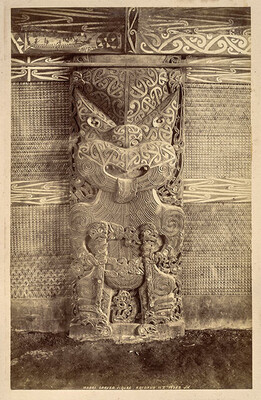B.
Maori Carved Figure. Rotorua. N.Z.
Collection
This article first appeared as 'Picture perfect postcards of our prominent places' in The Press on 25 March 2015.
In the late nineteenth century before the arrival of the popular postcard, and before picture-hungry visitors to exotic places carried their own Kodak cameras, there was just one choice of souvenir picture keepsake. That was, if a professional photographer had been there first. Like this arresting photograph of a Māori carved ancestral figure from Rotorua, the images they created were generally of a high quality, being contact printed on fine albumen paper, with sharp images delivered in rich, sepia tones. Once home, the returned traveller could frame the prints or affix them into handsome leather-bound albums.
In April 1892, to the likely consternation of many of this country's commercial landscape photographers, a representative from Valentine & Sons of Dundee, Scotland – one of the largest photographic publishing firms in the world – arrived in Auckland, ready to spend the next nine or so months traversing New Zealand to create a generous inventory of saleable views. John Samuel Powell (1848-1915) in his 20 years with the firm had already ventured to many places; throughout Great Britain and Ireland, on the Continent, in Norway and Iceland, and most recently in Morocco, Tunis and Spain. In the North Island, this seasoned traveller was conducted by the firm's agent, Auckland bookseller George Chapman, and in the South by Chapman's brother, gaining 'the advantage of their local knowledge and general acquaintance with the colony'. At the completion of Powell's visit, his New Zealand photographs would be placed with Valentine & Sons 'numerous agents throughout the world'.
Some of Powell's excursions were detailed in the papers, including his visit in June 'to the Hot Lakes district, a never-failing mine of wealth to the photographic artist.' En route to Rotorua, Powell's 'first point of attack' was the Okoroire resort, where he stayed for a week before heading to Whakarewarewa. Making day trips to nearby places of interest over the next three weeks, his itinerary included Tarawera, the buried village of Te Wairoa, Waiotapu and Tikitere; 'The Ohinemutu pa, with its quaint surroundings, and the interior of the Tamatekapua Meeting house, with its interesting rows of grotesque figures, were also taken.'
This fine and rare photograph of a poupou from Tamatekapua was recently 'returned' to New Zealand from France. The photographer's art has captured a contemporaneous art form; carving from the Ngāti Whakaue meeting house at Ōhinemutu on the shores of Lake Rotorua, built in the latest Māori architectural style in 1878. The house was named after Tama-te-kapua, captain of the Te Arawa migratory canoe, whose brother Whakatūria is represented in this carving, even though he had not lived to make the great voyage. Both brothers' likenesses in the meeting house are seen holding stilts, relating to an incident in their homeland of Hawaiki that had led to the migration some 600 years before.
The photograph is packed with detail, including highly refined whakairo (carving), tukutuku (woven wall panels) and kowhaiwhai (painted rafter designs), all of which appear still quite new. Working in limited, natural lighting, Powell captured the complexity of the different elements skilfully, giving due prominence to the artistry involved. This photograph is evidence of the hidden riches of Aotearoa New Zealand's cultural traditions and their diverse places of origin.
Ken Hall

